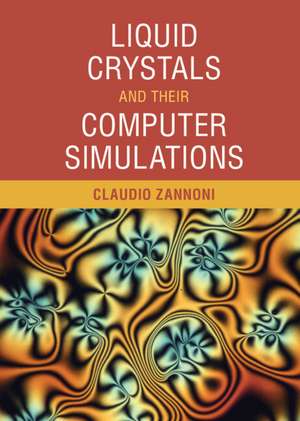Liquid Crystals and their Computer Simulations
Autor Claudio Zannonien Limba Engleză Hardback – 27 iul 2022
Preț: 537.50 lei
Preț vechi: 584.23 lei
-8% Nou
Puncte Express: 806
Preț estimativ în valută:
102.85€ • 107.66$ • 85.60£
102.85€ • 107.66$ • 85.60£
Carte disponibilă
Livrare economică 10-24 martie
Livrare express 22-28 februarie pentru 61.17 lei
Preluare comenzi: 021 569.72.76
Specificații
ISBN-13: 9781108424059
ISBN-10: 1108424058
Pagini: 650
Dimensiuni: 175 x 250 x 40 mm
Greutate: 1.31 kg
Ediția:Nouă
Editura: Cambridge University Press
Colecția Cambridge University Press
Locul publicării:Cambridge, United Kingdom
ISBN-10: 1108424058
Pagini: 650
Dimensiuni: 175 x 250 x 40 mm
Greutate: 1.31 kg
Ediția:Nouă
Editura: Cambridge University Press
Colecția Cambridge University Press
Locul publicării:Cambridge, United Kingdom
Cuprins
Preface. 1. Phases and mesophases; 2. Phase transitions; 3. Order parameters; 4. Distributions; 5. Particle-particle interactions; 6. Dynamics; 7. Molecular theories; 8. Monte Carlo; 9. Molecular dynamics; 10. Lattice models; 11. Molecular simulations; 12. Atomistic simulations. Appendices. References. Subject index.
Recenzii
'This is the first comprehensive textbook on computer simulations of liquid crystals, written by its pioneer and white knight, Prof. Claudio Zannoni. The book's unique quality is in its demonstration of how the often-mysterious properties of liquid crystals are shaped by microscopic interactions. The presentation follows decades of world-leading research by the author and his group in Bologna and is a must-read for both newcomers and experts in the science of liquid crystals; it will also benefit scientists in other fields, most notably soft matter.' Oleg D. Lavrentovich, Kent State University
'Prof. Zannoni's book provides a comprehensive introduction to liquid crystals and how to simulate them … Liquid crystals compose a particularly interesting area of soft matter, where models of different resolution can provide different insights into phases and their properties. As such, the book covers a range of models from lattice simulations to coarse-grained molecular models, to atomistic models. Many of these models have been used, and in some cases developed, by Prof. Zannoni himself over the course of an illustrious scientific career in the field … This is an extraordinarily detailed book and will provide researchers who are new to the field with a lifetime's worth of background knowledge, state-of-the-art results, and references. It is absolutely a 'must-read' for anybody starting out in the fields of liquid crystals and molecular simulation.' Mark Wilson, University of Durham
'[This] impressive book gives a comprehensive account of the science of liquid crystals, from the microscopic, molecular, viewpoint… The title somewhat under-sells the full scope of the book, which embraces experiment and theory as well as simulation. Indeed, the book explains how we use a whole range of experimental techniques, as well as the detailed information generated by molecular dynamics and Monte Carlo simulations, to understand how and why molecules form mesophases, how they are arranged, and how they move… this is a wonderful piece of work, containing a wealth of information and detail, and it indeed fills a large gap in the field. The scope is extremely ambitious, especially considering the necessary mathematical background, but Professor Zannoni has succeeded admirably in covering such a range, while making it so readable… extremely useful, both as a reference for established researchers in the field, and as a starting-out point for graduate students.' Michael P. Allen, Liquid Crystals Today
'Prof. Zannoni's book provides a comprehensive introduction to liquid crystals and how to simulate them … Liquid crystals compose a particularly interesting area of soft matter, where models of different resolution can provide different insights into phases and their properties. As such, the book covers a range of models from lattice simulations to coarse-grained molecular models, to atomistic models. Many of these models have been used, and in some cases developed, by Prof. Zannoni himself over the course of an illustrious scientific career in the field … This is an extraordinarily detailed book and will provide researchers who are new to the field with a lifetime's worth of background knowledge, state-of-the-art results, and references. It is absolutely a 'must-read' for anybody starting out in the fields of liquid crystals and molecular simulation.' Mark Wilson, University of Durham
'[This] impressive book gives a comprehensive account of the science of liquid crystals, from the microscopic, molecular, viewpoint… The title somewhat under-sells the full scope of the book, which embraces experiment and theory as well as simulation. Indeed, the book explains how we use a whole range of experimental techniques, as well as the detailed information generated by molecular dynamics and Monte Carlo simulations, to understand how and why molecules form mesophases, how they are arranged, and how they move… this is a wonderful piece of work, containing a wealth of information and detail, and it indeed fills a large gap in the field. The scope is extremely ambitious, especially considering the necessary mathematical background, but Professor Zannoni has succeeded admirably in covering such a range, while making it so readable… extremely useful, both as a reference for established researchers in the field, and as a starting-out point for graduate students.' Michael P. Allen, Liquid Crystals Today
Notă biografică
Descriere
A comprehensive introduction to liquid crystals and their computer simulations suitable for students, researchers and industrial scientists.
